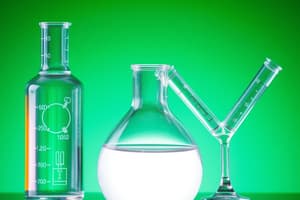Podcast
Questions and Answers
How is the rate of a chemical reaction typically measured?
How is the rate of a chemical reaction typically measured?
- In terms of the change in concentration of the reactants (correct)
- In terms of the stoichiometric coefficients
- In terms of the change in concentration of the products
- In terms of the change in temperature
What is the mathematical representation of the rate of change of reactant A over time?
What is the mathematical representation of the rate of change of reactant A over time?
- $\frac{d[A]}{dt}$ (correct)
- $\frac{d[B]}{dt}$
- $\frac{d[C]}{dt}$
- $\frac{d[A]}{dt} \times \frac{1}{\text{{stoichiometric coefficient of A}}}$
Which of the following best defines chemical kinetics?
Which of the following best defines chemical kinetics?
- The study of the stoichiometric coefficients in a chemical reaction
- The study of the products formed in a chemical reaction
- The study of the change in concentration of reactants over time
- The study of the rate of a chemical reaction (correct)
What is the equivalent representation of the rate of change of reactant B over time?
What is the equivalent representation of the rate of change of reactant B over time?
What does a negative sign in the rate expression indicate?
What does a negative sign in the rate expression indicate?
Which of the following best describes chemical kinetics?
Which of the following best describes chemical kinetics?
What is the mathematical representation of the rate of change of reactant A over time?
What is the mathematical representation of the rate of change of reactant A over time?
What does a negative sign in the rate expression indicate?
What does a negative sign in the rate expression indicate?
How is the rate of a chemical reaction typically measured?
How is the rate of a chemical reaction typically measured?
What is the equivalent representation of the rate of change of reactant B over time?
What is the equivalent representation of the rate of change of reactant B over time?
Flashcards are hidden until you start studying




